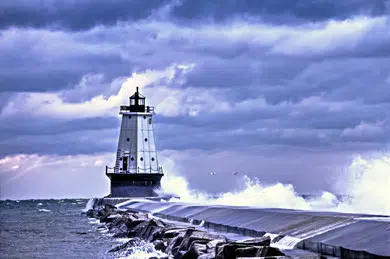The U.S. Army Corps of Engineers, Detroit District, strongly urges people to use caution around breakwaters, piers or jetties in the Great Lakes and to adhere to posted warning signs. Do not swim near or jump off any structure, the life you save may be your own.
Most accidents and incidents near harbor structures occur during the turbulent weather season from late August through December. The lakeshore attracts local residents and visitors alike. Visitors may not be aware of the powerful impacts that high winds and storms can bring to the shoreline and harbor structures. Weather conditions during this time can cause waves to wash over the top of structures, creating slippery surfaces and enough force to knock a person off and into the water. Even low waves washing over a person’s feet can knock them down and cause a situation where they are unable to react. All of these factors combine to make a trip to the breakwater a risky proposition.
It’s beautiful, but dangerous. Fishermen, swimmers, nature lovers and sightseers all love the beauty and pleasure of walking on a breakwater. Although the structures were primarily built for ship navigation, they are also often used for recreation. It is imperative that users know the risks and responsibilities to safely use them. The beauty and majesty of the waves crashing and spraying against the breakwaters, piers and jetties mask the hazards. Harbor structures pose various dangers: slick surfaces, jagged and sharp edges, structural currents, as well as large rocks hidden beneath the water’s surface.
Designed for protection. Breakwaters are designed to reduce wave action in channels and harbors. These structures can withstand over 50 years of pounding waves, several feet of piled ice and even an occasional ship collision. Their design hides their robust nature. Just like an iceberg, most of a breakwater is below water and the pleasant view above the water disguises the danger below.
Hazards below. Enormous armor stones, quarried rock buttressing the pier or breakwater, provide support for the structure’s steel and concrete, and are hidden beneath the waves.
Individually, these rocks weigh between one and 40 tons. Danger is always present regardless of the water level, but low water makes the situation more dangerous, as the rock is closer to the surface. There is severe risk of getting wedged between armor stones or slamming into them should an individual fall or jump into the water.
Water Dangers. While many victims who have fallen or jumped off these structures were said to have been very good swimmers, the reality of past statistics paint a sad picture. In 2018 so far, there have been 102 drownings in the Great Lakes. Though not all of these drownings occurred at harbor structures, it is a grim reminder of the risks and dangers that are present when in and around water.
Rip currents, structural currents, and cold water shock are a common cause of drowning. Rip currents are fast-moving, narrow currents of water that flow away from shore. Structural currents can occur at fixed structures such as breakwaters and piers, and flow away from shore parallel to the structure. Cold water temperatures can also be very dangerous. Becoming suddenly immersed in cold water (60°F degrees and colder) can cause cold water shock during the first minute of exposure. Cold water shock causes gasping and difficulty in breathing, followed by muscle failure, all of which can lead to drowning.























